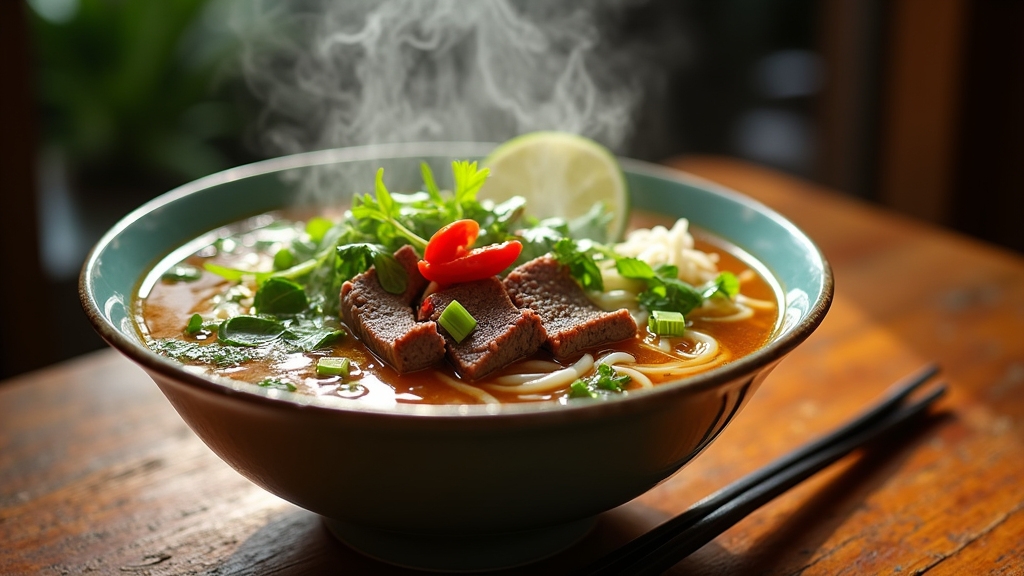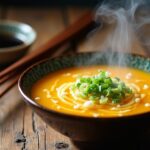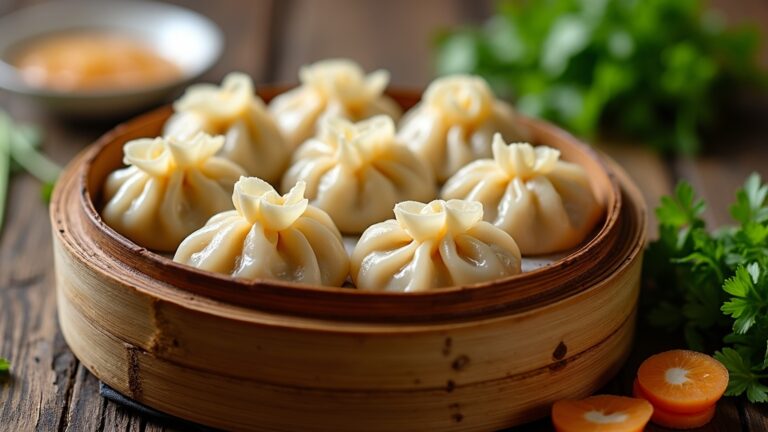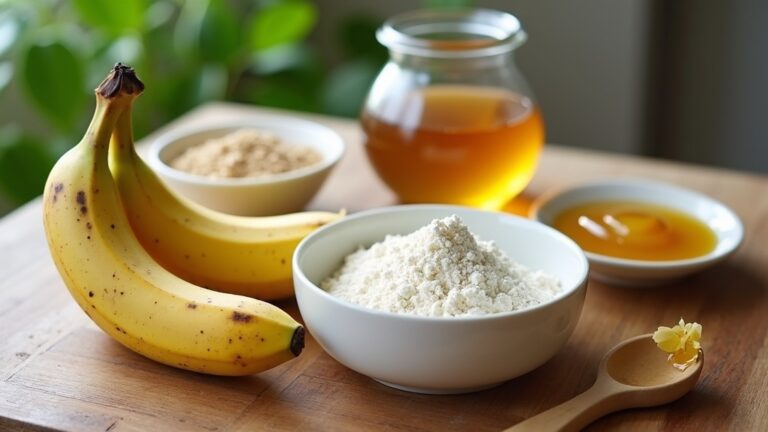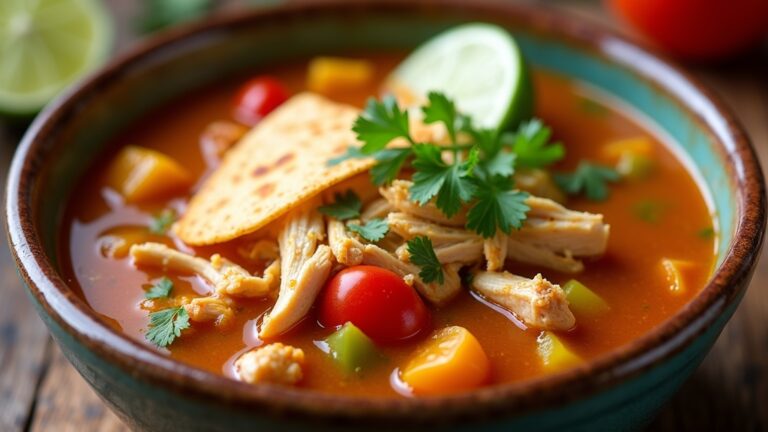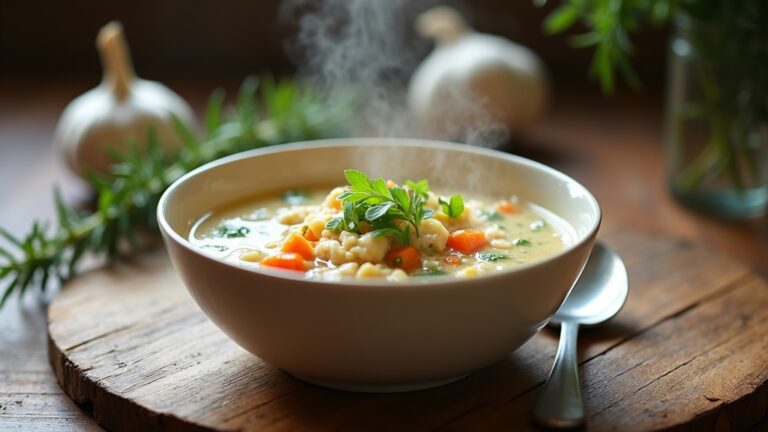Pho Soup Recipe Easy
If you’re looking for an easy pho soup recipe, I’ve got you covered! Start by simmering beef bones or chicken with charred onions and ginger for a beautifully rich broth. Add spices like star anise and cinnamon for that distinctive flavor. Cook rice noodles until just al dente, then layer in your choice of protein. Don’t forget the fresh herbs and lime for garnish. Each bowl is a warm hug for the soul, and there’s so much more to explore!
Contents
History
When I think about the history of pho, I’m often amazed at how this beloved Vietnamese dish has evolved over the years. Its Vietnamese origins date back to the early 20th century, rooted in the French colonial influence and local culinary traditions. Initially a humble street food, pho quickly gained cultural significance, becoming a symbol of national identity, especially after the Vietnam War. I find it fascinating how each region in Vietnam puts its unique spin on pho, adding local flavors and ingredients. This adaptability not only showcases the dish’s versatility but also reflects the Vietnamese spirit of innovation. Pho connects people through shared meals, stories, and memories, making it much more than just a bowl of soup—it’s a celebration of culture and community.
Recipe
Pho soup is a beloved Vietnamese dish that embodies a perfect harmony of flavors, textures, and aromas. At its heart, pho is a fragrant broth, traditionally made from simmered beef bones and a blend of spices, including star anise, cinnamon, and cloves. This rich broth serves as the foundation for the dish, bringing warmth and comfort to those who enjoy it. The beauty of pho lies in its versatility; it can be customized with various proteins, vegetables, and garnishes, making it a delightful meal for any palate.
To create an authentic pho experience, it’s essential to focus on the quality of the ingredients, especially the broth. A slow simmer allows the flavors to meld beautifully, resulting in a bowl of pho that is both deeply satisfying and nourishing. Traditionally served with rice noodles, fresh herbs, and a squeeze of lime, this soup is not just a meal but a celebration of Vietnamese culture and culinary tradition. With a little patience and care, you can recreate this iconic dish in your own kitchen.
Ingredients:
- 2 pounds beef bones (preferably marrow bones)
- 1 pound beef brisket
- 1 onion, halved
- 1 ginger root, halved
- 5 star anise
- 2 cinnamon sticks
- 4 cloves
- 1 tablespoon coriander seeds
- 1 tablespoon salt
- 1 tablespoon sugar
- 1 package rice noodles (banh pho)
- Fresh herbs (basil, cilantro, mint)
- Lime wedges
- Bean sprouts
- Sliced jalapeños (optional)
- Hoisin sauce (for serving)
- Sriracha sauce (for serving)
To make the pho broth, begin by roasting the halved onion and ginger under the broiler until they are charred, about 10-15 minutes. In a large pot, combine the beef bones, brisket, charred onion, ginger, star anise, cinnamon sticks, cloves, coriander seeds, salt, and sugar. Fill the pot with enough water to cover the ingredients, then bring to a boil. Once boiling, reduce the heat to low and let it simmer gently for at least 4 hours, skimming off any impurities that rise to the surface. After simmering, strain the broth to remove solids and return it to the pot. Cook the rice noodles according to package instructions, then assemble bowls with noodles, sliced brisket, and hot broth. Serve with fresh herbs, lime wedges, bean sprouts, and optional condiments.
When cooking pho, remember that the longer you simmer the broth, the richer the flavor will be. If you want to save time, you can use a pressure cooker for a quicker broth. Additionally, feel free to experiment with different proteins, such as chicken or tofu, to suit your preferences. Always serve pho hot, and encourage your guests to customize their bowls with their favorite toppings. Enjoy the process, and don’t hesitate to share your unique twist on this classic dish!
Cooking Steps
Now that we’ve gathered all our ingredients, I can’t wait to walk you through the cooking steps that will bring this pho soup to life. First, I’ll show you how to prepare the broth, infusing it with aromatic spices and herbs for that signature flavor. Once we’ve simmered everything to perfection, we’ll finish it off with noodles, proteins, and a vibrant garnish of fresh herbs.
Step 1. Prepare Broth Ingredients
To create a rich and flavorful broth for your pho, I gather several key ingredients that will form the foundation of this beloved dish. First, I decide on my broth types—beef or chicken—depending on my craving. For a beef broth, I select marrow bones, brisket, and oxtails, ensuring a deep, meaty flavor. If I’m going for chicken, I choose a whole bird or thighs for that comforting taste. Next, I pick fresh ingredients like onions and ginger, which I char for an added depth. I also include fish sauce for a savory kick. This thoughtful ingredient selection allows me to build a broth that’s both aromatic and satisfying, setting the stage for a delightful pho experience.
Step 2. Add Spices and Herbs
As I prepare to enhance my broth, I reach for a selection of spices and herbs that will elevate the flavors of my pho. The right blend is essential, so I opt for a few aromatic additions that reflect the essence of Vietnamese cuisine. I love experimenting with various spice blends and herb varieties that tantalize the taste buds. Here’s what I typically include:
- Star anise for a sweet, licorice-like flavor
- Cloves to add a warm, rich depth
- Cinnamon sticks for warmth and sweetness
- Fresh basil for a fragrant, herbal note
Each of these elements contributes to a complex, layered broth that’s both comforting and invigorating. With these spices and herbs, my pho becomes an unforgettable experience!
Step 3. Simmer for Flavor Infusion
After adding the spices and herbs, the next step is to simmer the broth, allowing all those flavors to meld beautifully. I bring the heat down to a gentle simmer, which is essential for effective flavor extraction. Using simmering techniques, I let the mixture bubble softly, creating a fragrant aroma that fills my kitchen. This slow cooking process helps draw out the essence of each ingredient, producing a rich, savory broth that’s the heart of the pho. I often check in, skimming off any foam that rises to the surface, ensuring clarity in the final product. It’s a mesmerizing experience, watching the broth transform as it simmers, promising a delicious and complex flavor profile in every spoonful.
Step 4. Add Noodles and Proteins
Once the broth has simmered to perfection, it’s time to add the noodles and proteins that will bring the dish to life. I love this part because selecting the right combinations elevates the entire bowl. Here’s what I usually consider:
- Noodle types: Rice noodles are classic, but feel free to experiment with egg noodles or even zucchini noodles for a twist.
- Protein options: Thinly sliced beef, tender chicken, or tofu for a vegetarian choice.
- Cooking time: Verify the noodles are cooked just right—al dente is the goal.
- Layering flavors: Add proteins to the simmering broth for a few minutes to absorb all those delicious flavors.
This is where the magic really happens, and your pho starts to take shape!
Step 5. Garnish With Fresh Herbs
One of the most delightful aspects of pho is the vibrant garnish that brings the dish to life. As I finish my soup, I can’t resist adding a generous handful of fresh basil. Its aromatic leaves not only enhance the flavor but also provide a pop of color. Next, I sprinkle in a few cilantro sprigs, which add a invigorating brightness that complements the savory broth beautifully. I love the way these herbs dance on the surface, inviting anyone nearby to plunge in. To elevate the experience, I might even toss in some sliced jalapeños or a wedge of lime for a zesty kick. With each bite, I savor the aromatic explosion that these fresh herbs create, making my pho truly unforgettable.
Nutritional Guide
While enjoying a steaming bowl of pho can be a delightful experience, understanding its nutritional benefits adds another layer to this beloved dish. Pho is not just comfort food; it’s packed with health benefits! The combination of fresh herbs, lean proteins, and rich broth contributes to its appeal.
Here’s a quick nutritional guide:
| Nutrient | Amount per Serving | Health Benefits |
|---|---|---|
| Calories | 350 | Energy source |
| Protein | 25g | Muscle repair and growth |
| Fiber | 3g | Aids digestion |
| Vitamins A & C | Varies | Supports immune function and vision |
Final Thoughts
As you savor each flavorful spoonful of pho, it’s easy to appreciate not just its rich taste but also the healthy ingredients that make it a well-rounded meal. Beyond the deliciousness, pho offers numerous soup benefits and embodies cultural significance that connects us to its roots.
Consider these innovative aspects:
Innovative aspects of pho highlight its nutrient balance, comforting nature, community spirit, and versatility for all dietary needs.
- A balance of nutrients from herbs and spices
- Comfort food that soothes the soul
- A dish that fosters community and shared experiences
- Versatility to adapt to various dietary preferences
In a world craving connection and nourishment, pho stands out as a vibrant choice. Embrace the warmth and richness it brings to your table, and let each bowl tell a story of tradition and health.
Frequently Asked Questions
Can I Use Beef Instead of Chicken for Pho Soup?
I love using beef instead of chicken for pho. The beef broth adds a rich, hearty flavor profile that elevates the dish, making it even more satisfying and innovative. You won’t regret trying it!
What Type of Noodles Are Best for Pho?
When choosing noodles for pho, I love using rice noodles. They soak up the broth beautifully, enhancing the dish’s flavor. Pairing them with fresh pho ingredients creates a delightful, authentic experience that’s hard to beat!
How Long Can I Store Leftover Pho Soup?
I’ve found leftover storage for pho soup works best in an airtight container. It keeps well in the fridge for about three to four days. Proper soup preservation guarantees you enjoy those flavors again soon!
Is Pho Soup Gluten-Free?
Isn’t it amusing how we chase gluten-free options like they’re elusive unicorns? While traditional pho isn’t gluten-free, I’ve found delicious broth alternatives that let me enjoy this dish without sacrificing my dietary needs.
Can I Make Pho Soup Vegetarian?
Absolutely, I can make pho soup vegetarian! I love using tofu or tempeh for vegetarian protein options and experimenting with mushroom or vegetable broth alternatives. It’s a delicious twist that still captures pho’s essence.
Conclusion
In the end, making pho soup is like wrapping yourself in a warm, comforting blanket on a chilly day. It’s not just a meal; it’s a connection to rich traditions and flavors that can brighten even the dullest of days. I hope you immerse yourself in this recipe and savor every spoonful. With each sip, you’ll find not just nourishment, but a little piece of culture and love. So, grab your ingredients and let’s get cooking!
